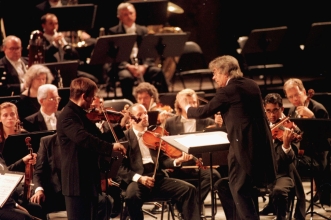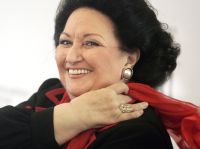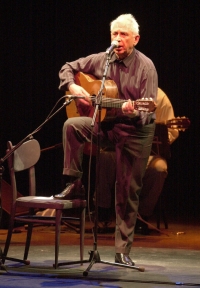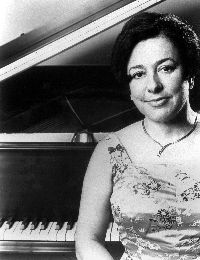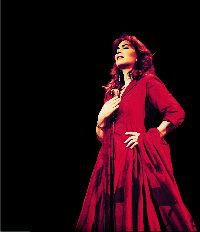

Music 
Catalan symphonic music has produced great composers and performers of international renown. Felip Pedrell (1841-1922) had a great influence on Catalan music, becoming the master of composers such as Enric Granados (1867-1916) and Isaac Albéniz (1860-1909), representative names in the Modernista movement in music; of the avant-garde composer Robert Gerhard (1896-1970) and of Enric Morera (1865-1942), composer of operas and sardanas, Catalonia’s
traditional dance. Music at the amateur level received a great impetus thanks to Anselm Clavé (1824-1874), who introduced choral societies to the Iberian peninsula. The Federació de Cors Clavé has been in existence for over a century and is still very active. The popular taste for choral music led to the foundation of large choral societies, culminating in the Orfeó Català (1891) and the Societat Catalunya Nova (1895). Updating Catalan traditional songs with “toy” music is the speciality of composer and multi-instrumentalist Pascal Comelade (1955).
The most universally-admired figure in 20th-century Catalan music is Pau Casals (1876-1973). There is a before and after in his cello performances as he introduced a series of innovations that founded an interpretive movement. He showed a great talent for music from infancy. When he was 23 he began his professional career, performing in the world’s great auditoria. He was also a teacher, orchestral conductor and composer, with works such as the oratorio El Pessebre. During the Civil War he never wanted to leave the country; he devoted his time to raising funds with benefit concerts and became honorary president of the Committee of Musicians in support of Spanish democracy. In 1939 he went into exile with the firm intention of never returning to Catalonia while Franco was in power. He lived in Prada de Conflent from 1939 to 1957, and chose to be musically silent until 1950, when various musician friends convinced him to stage a festival in Prada in benefit of Republican refugees. Every summer this festival still remains a magnet for lovers of chamber-music. In 1957 he moved to Puerto Rico and continued his career around the world until his death in 1973. Casals’ attitude throughout his life was one of utter commitment to peace and liberty. An example of his personal legacy is the Hymn of the United Nations (1971).
Another outstanding figure from the first half of the 20th century was Eduard Toldrà (1895-1962), first as a violinist in his youth; between 1921 and 1936 as a composer of symphonic works; and after the Civil War, from 1943, as a conductor with a number of international orchestras. The pianists Alicia de Larrocha (1923) and Leonora Milà (1942) took Catalan and Spanish music into the major concert-halls of the world at the height of the Franco dictatorship.
In the field of composition there is also the work of Frederic Mompou (1893-1987), after whom a chair at the Graduate Center of the City University of New York has been named since 2003, Xavier Montsalvatge (1912-2002) and his contemporaries Joaquim Homs (1906), Josep Maria Mestres Quadreny (1929) and Joan Guinjoan (1931).
Catalan culture has made a great contribution to the world of opera since the early 20th century with artists such as Francesc Viñas (1863-1933), a tenor who triumphed wherever he went with the music of Wagner, and Maria Barrientos (1884-1946), a light soprano and leider-singer who performed at the major venues in Europe and America. Throughout the last century and up to the present day, the world of music has been enriched by the tenors Jaume Aragall (1939) and Josep Carreras (1946), the baritone Joan Pons (1946) and the sopranos Victòria dels Àngels (1923-2005) and Montserrat Caballé (1933).
One of the most special people in Catalan music is Jordi Savall (1941), who for more than 30 years has devoted himself to rescuing, investigating and disseminating ancient and Baroque music to a variety of audiences around the world. Recognised as a great viola da gambist, and also as a conductor, Savall has founded several ensembles (La Capella Reial, Hespèrion XXI and Le Concert des Nations) as well as his own recording label, to make the music of the past alive in the present.
As for music with jazz roots, outstanding figures from the 20th century include the world-famous band-leader and composer Xavier Cugat (1900-1990) and the great pianist Tete Montoliu (1933-1997). The longest-standing ensembles are La Locomotora Negra (1971) and La Vella Dixieland (1980). The baton has been taken up by, amongst others, Jordi Rossy, (1964), percussionist and pianist; pianist Albert Bover and saxophonist Llibert Fortuny (1977). With jazz roots and a feeling for musical exploration that makes him unique, Agustí Fernández (1954) has consolidated his standing as an improvisationalist.
Flamenco also forms part of Catalan musical culture with outstanding figures such as the bailaora Carmen Amaya (1913-1963) and singers Juan Rafael Cortés Santiago, Duquende (1965), Maite Martín (1965) and Miguel Poveda (1973). At the height of the dictatorship, in the 1950s, Catalan culture developed the rumba catalana, born amongst Barcelonese Roma families in the district of Gràcia. The foundations of the genre were laid by Antonio González, El Pescaílla (1926-1999) and by Pere Pubill Calaf, Peret (1935), who has continued to consolidate it up until the present. Between 1978 and 1987 the rumba was represented by Gato Pérez (1951- 1990), who was a great influence on the ethnic fusion music which since the 1990s has made Barcelona a meeting-place for performers from around the world, with groups such as Cheb Bawlowski, Ojos de Brujo, Pomada and Troba Kung Fú.
In the 1960s the protest song movement gathered strength with the group of Catalan singer-songwriters known as the 16 Jutges, made up of sixteen young people who sang in Catalan, a language which was prohibited under the Franco dictatorship. Some members of the group are still pursuing their careers with an enviable international reputation. This is the case of Raimon (1940), Lluís Llach (1948), Joan Manuel Serrat (1943) and Maria del Mar Bonet (1947). The tradition of Catalan singer-songwriters continues with a new generation, including, for example, Roger Mas (1975) and Feliu Ventura (1976). In the mid-1970s groups were formed such as Al Tall (1974), amongst whose founders was Miquel Gil, one of the best-known singer-songwriters of the moment, or Companyia Elèctrica Dharma (1974). The 80s were the years of so-called “rock català”, with groups like Sau, Sopa de Cabra, Els Pets and Lax’n Busto.
The most iconic musical venues are the Palau de la Música, a Modernista work by Lluís Domènech i Montaner, built between 1905 and 1908 and declared a World Heritage site by UNESCO in 1997, and the Gran Teatre del Liceu, founded in 1847 and rebuilt in 1999 after a fire, which has become one of the world’s leading opera houses. Also in 1999, L’Auditori was opened, a building designed by Rafael Moneo which, as well as containing three concert-halls, is also the home of the Higher School of Music of Catalonia and of the Music Museum.
A variety of summer festivals are held all around Catalonia which offer the opportunity of enjoying music in settings of great artistic interest such as Peralada castle or various monasteries on the Cistercian Route, such as Sant Pere de Rodes. With the return of democracy these festivals of music in a variety of genres have become magnets for music-lovers. Examples are the Terrassa Jazz Festival and the Blues Festival in Cerdanyola, which has been held now for two decades. Since 1994, the SONAR Festival of Advanced Music and Multi-media Art has become a mecca for the world’s musical avant-garde.

